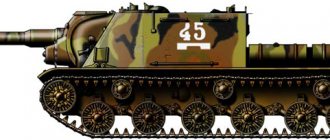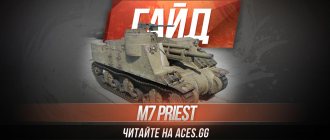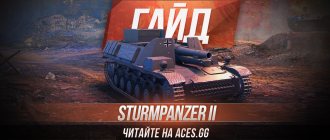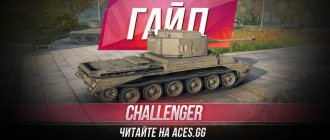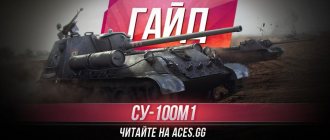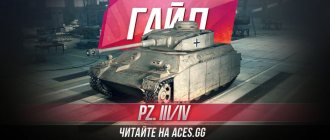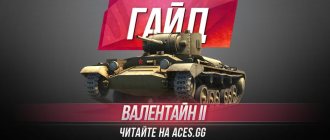Historical reference.
In the second half of the war, the only representative of the high command whose head was not turned by Adolf Hitler's gigantomania was Heinz Guderian. It was his persistence, to which the narcissistic Fuhrer, who firmly believed in his own military talent, sometimes listened, seriously delayed the defeat of Germany. The creation of a maneuverable and stealthy tank destroyer, which the Hetzer eventually became, belonged to Guderian.
As it turned out later, he was right. The simplicity of the design of the AT, created on the basis of the Pz 38t, which combined a low silhouette, good frontal armor and sufficient firepower, made the Hetzer a completely effective anti-tank weapon that the German industry could produce in large quantities. These anti-tank vehicles were able to quietly approach enemy positions, successfully hit their armored targets from close and medium distances, and evade retaliation by losing sight of the nearest cover.
At different times, these vehicles were classified differently and belonged to different troops. First to the artillery, later to the tank destroyers.
By the way, it would be more correct to call this tank JagdPanzer 38t, since the name Hetzer was assigned to the E-10 tank destroyer being developed. However, due to its similarity, the JagdPanzer 38t began to be called “Hetzer”.
Jagdpanzer 38 Hetzer
Jagdpanzer 38 Hetzer
click the image and see the gallery
Creation and development of Jagdpanzer 38
The combat practice of the German army showed the urgent need to create a single vehicle instead of the accumulated numerous variants of self-propelled guns with their endless modifications. The diversity of the fleet of German self-propelled guns increasingly backfired on Germany: the confusion in the tactical use of motley vehicles was accompanied by constant difficulties with supplies and training of crews. All kinds of self-propelled guns finally needed to be somehow unified. This idea was first voiced at a high level by Heinz Guderian in March 1943. The so-called Panzerjager program was launched. The new machine was supposed to be as simple as possible, cheap, highly mobile, efficient and suitable for production in large quantities. Since the German tank industry was chronically unable to cope with the production of the required amount of armored vehicles, in order not to reduce the production of German tanks, it was proposed to take the chassis of the outdated Czech light tank PzKpfw 38(t) as the basis for the new vehicle. The Pz V Ausf tank was taken as the standard of manufacturability. A, Panther (Sd. Kfz. 171): for the same man-hours that were spent on the production of one Panther, it was necessary to make 3 new vehicles with equal firepower.
However, the bold idea of a powerful self-propelled gun based on the Pzkpfw 38 (t) did not arouse enthusiasm among any of the developers. Perhaps this idea would have continued to languish on the shelf if industrialized America had not intervened. The industrial potential of the United States had its say in the fact that on November 26, 1943, allied aviation dropped 1,424 tons of bombs on Berlin. This air raid severely destroyed the workshops of the Alket company, which produced assault guns. At the same time, the bombing shook off the dust from the idea of a new self-propelled gun, and the German command began to look for alternative production facilities to compensate for the faltering production of the StuG. The VMM plant, inaccessible to allied bombers, came into the field of view of the OKN. On December 6, 1943, OKN reported to Hitler that the VMM would not be able to handle the assembly of a 24-ton StuG, but could handle a light Panzerjager. Hitler had to agree that VMM should completely switch to the production of a new light machine. The requirements for the future Panzerjager were: - weight 13 tons - maximum speed 55-60 km/h - frontal plate 60mm thick with a good slope - anti-fragmentation side and rear armor
The new car was created at amazing speed. Already on December 17, 1943, the Fuhrer was shown the drawings, which he approved. Against the backdrop of the growing gigantomania in German tank building, Hitler would have preferred a heavier vehicle. However, VMM could only handle the easy one and Hitler agreed.
On January 24, 1944, a wooden model was ready, and on January 26 it was shown to the Armaments Department of the Ground Forces (Heers Waffenamt). I liked the project and Oberst Tomale ordered the production of three vehicles by March for military testing.
On January 28, 1944, Hitler pointed out the importance of rapid production and increased production of the leichte Sturmgeschutz auf 38(t) as the most important vehicle for the army in 1944.
The Leichte Sturmgeschutz auf 38(t) was ready for serial production in less than 4 months. A number of pre-production tests were ignored because, on the one hand, time was very pressing, and on the other, the Pzkpfw 38 (t) base was already well known. By January 18, 1944, it was determined that monthly production should reach 1000 vehicles by March 1945. By German standards this was a very significant number. Two companies were responsible for the production of Hetzers - BMM and Skoda.
| initial production plan for the Jagdpanzer 38 Hetzer | ||||||||||||
| firm | Apr | Mar | Jun | Jul | Aug | Sep | Oct | but I | Dec | Jan | Feb | Mar |
| BMM | 20 | 50 | 100 | 200 | 250 | 300 | 350 | 400 | 400 | 400 | 450 | 500 |
| Skoda | 0 | 0 | 0 | 10 | 50 | 100 | 150 | 200 | 300 | 400 | 450 | 500 |
The first 3 vehicles were manufactured at VMM in March 1944 and tested. In April, the Waffenamt adopted them.
On April 20, 1944, Hitler's birthday, the leader of the Reich was pleased to be shown the next 20 Hetzers. However, after the demonstration, the equipment was sent back to the plant to be completed to the required level.
The production of Hetzers increased rapidly, but the rush had a negative impact on quality. ACS receivers noted frequent defects: in the gas lines between two fuel tanks, in the carburetor, in air filters, leaks in seals, sparking. The Waffenamt had to reduce its monthly production level from August to December 1944 so that workers could do their jobs better.
In July 1944, Skoda made its first 10 Hetzers.
Armor parts for Hetzer were supplied by 4 companies: Skoda (Pilsen), VMM, Linke Hoffman (Breslau), Poldihutte (Komatow).
Time passed, and Allied air raids reached the territory of the Czech protectorate. In December 1944, the Allies carried out airstrikes on Skoda factories three times, dropping 375 tons of bombs. In January 1945, Skoda reached its peak production of 434 Hetzers per month. This company never reached that number again and never reached the planned rate of 500 cars per month. The disruption of Hetzer production lies entirely on the conscience of the Allied bombers. After February 1, 1945, an additional order was received for only 2,100 Hetzers. Allied aviation did not forget about the VMM. Heavy bombing forced the transfer of part of Hetzer's production to other, often unprofitable companies. So, with BMM Werk Prag/Luben, part of the Hetzer assembly was moved to the city of Milowitz. There was no longer any need to talk about any fulfillment of the Hetzer release plan.
Soon difficulties began with the guns supplied for the Panzerjager 38(t) from Germany. There were not enough guns, or there were no sights for them, or the guns arrived without guidance mechanisms. It got to the point that in order to fulfill the order, it was necessary to remove the sights and guidance mechanisms from the 8 Hetzer Starr located at the tank school in Milovice. Considering the catastrophic situation with the supply of guns, the VMM was obliged to install another gun on the Hetzer - the 7.5cm StuK 40. The tests were supposed to end in mid-May 1945. In May 1945, Skoda was supposed to assemble 90 Hetzers with the StuK 40 cannon. On April 24, 1945, the Allies dropped 500 tons air bombs on Skoda. It is known that at the beginning of May 1945 Skoda produced several Hetzers, but the lack of documents does not allow us to accurately determine this number.
| monthly production of Jagdpanzer 38 Hetzer | |||||||||||||||
| Mar | Apr | May | Jun | Jul | Aug | Sep | Oct | but I | dke | Jan | Feb | Mar | Apr | Total | |
| planned | 20 | 50 | 100 | 175 | 175 | 250 | 330 | 350 | 380 | 430 | 350 | 350 | 250 | 3210 | |
| built | 3 | 20 | 59 | 102 | 110 | 178 | 237 | 240 | 406 | 332 | 478 | 417 | 320 | 10 | 3022 |
| BMM JgPz 38(t) | 3 | 20 | 50 | 100 | 100 | 150 | 190 | 133 | 298 | 223 | 289 | 273 | 148 | 70 | 2047 |
| BMM Bergepanzer | 8 | 2 | 8 | 14 | 50 | 19 | 39 | 19 | 19 | 3 | 181 | ||||
| BMM Starr | 1 | 3 | 5 | 5 | 14 | ||||||||||
| Skoda JgPz 38(t) | 10 | 20 | 30 | 57 | 89 | 104 | 145 | 125 | 153 | 47 | 780 | ||||
| handed over to the troops | 90 | 127 | 125 | 161 | 274 | 309 | 373 | 277 | 451 | 175 | 2362 | ||||
| Table includes 20 Hetzer converted to Flammpanzer and 75 Hetzer sold to Hungary in 1944-45 | |||||||||||||||
Jagdpanzer 38 design description
Hetzer was based on the Czechoslovakian TNHP light tank, which was originally called LT vz 38, and was renamed PzKpfw 38(t) in the German army. To install a powerful 75mm cannon, the Hetzer's hull had to be made wider than that of the tank. The self-propelled gun was originally conceived as a light tank destroyer, so only the front armor was serious. The upper frontal sheet, 60 mm thick, had an inclination of 60 degrees from the vertical. It was manufactured to specification E22 with a Brinell hardness of 265-309. The 20mm sides and stern protected only from fragments and were therefore made of low-alloy SM steel (Siemens-Marteneit) with a Brinell hardness of 220-265. The sides and rear of the hull are 15mm. The roof and aft sheet of the superstructure were made of 8mm rolled steel. Floor – 10mm. Thus, Hetzer had fairly good frontal armor and almost defenseless sides and stern. The weak armor was partially compensated by the small silhouette of the self-propelled gun.
The installation with a 7.5cm Pak 39 cannon was attached to the upper frontal plate with an offset to the right. The displacement of the gun led to a number of significant design flaws. The horizontal guidance of the gun turned out to be very limited - 5 degrees to the left and 11 to the right. The right suspension was 55 kilograms more loaded than the left.
A Rundumsfeuer, a 7.92mm MG 34 or MG 42 machine gun with remote control, was installed on the roof of the fighting compartment. The peculiarity of its design was that outside there was only the machine gun itself with a magazine and a small “double-winged” protective shield. The gunner controlled the machine gun from the fighting compartment. Aiming was carried out through a telescopic sight with 3x magnification and a viewing angle of 8 degrees. Despite all the advantages, Rundumsfeuer could not be called successful. The machine gun had not a belt feed, but a magazine feed, which was not enough for a long time. To reload, the loader had to lean out through his hatch and, being in a very awkward position, change the magazine. The machine gun shield could not provide him with normal protection, because it was designed to protect the machine gun itself and was placed so as not to cover the gun sight.
Hetzer stood out noticeably due to its cramped design, which was not typical for German cars.
The placement of the crew can also be called unsuccessful. On the left in one row sat: the driver, behind him the gunner and behind him the loader. All these three crew members had only one landing and evacuation hatch, located above the loader. The Germans were always very scrupulous about ensuring that in the event of an alarm the crew could quickly leave the vehicle. In this light, one hatch for three people looks simply shocking.
Gun maintenance was another shortcoming of Hetzer. Initially, the gun was designed to be installed in the middle of the front plate, so that the loader was on the right. However, on Hetzer the gun was so shifted to the starboard side that the loader could not fit there. Therefore, the loader had to sit on the left and reach over the bolt to the gun mechanisms installed on the right. Left-hand loading of a right-handed gun caused another serious inconvenience. The commander's workplace was again unsuccessful - on the left rear in a separate niche. The location of the commander, separated from the crew, did not contribute to cohesion and successful control during the battle.
The view from the car cannot be called optimal. Driver's binocular periscope; gun periscope sight Sfl.Z.1a and machine gun periscope - on the gunner; the loader's periscope fixed at 9 o'clock; telescopic stereo tube SFL4Z at the commander. With the hatches closed, the crew could hardly see what was happening on the starboard side.
Hetzer was armed with a 75mm PaK39 L/48 cannon. Ammunition - 41 shots. Range of gun ammunition:
Pzgr.40 - sub-caliber projectile with a tungsten core Pzgr.39 - armor-piercing tracer with explosives in the bottom Gr.38 HL - cumulative Sprgr.34 - high-explosive fragmentation grenade
| ammunition range 7.5cm Pak 39 Jagdpanzer 38 Hetzer | ||||
| projectile type | projectile weight, kg | projectile length, mm/club | explosive weight, kg | charge weight, kg |
| Sprgr.34 | 5,74 | 345/4,6 | 0,68 | 0,755 |
| Pzgr.39 | 6,8 | 282/3,76 | 0,02 | 2,43 |
| Pzgr.40 | 4,15 | 241/3,21 | — | 2,18 |
| Gr.38 HL/A | 4,4 | 284/3,79 | 0,4 | 0,43 |
| Gr.38 HL/B | 4,57 | 307/4,1 | 0,58 | 0,43 |
| Unary loading, brass-plated steel sleeve, length 445.1 mm, flange diameter 123 mm | ||||
The crews were advised that the ammunition load included at least 35% Pzgr.39. It was the most effective armor-piercing projectile. The sub-caliber Pzgr.40 had a weak armor effect due to the lack of explosives and strong dispersion over long distances. The cumulative Gr.38 HL could not guarantee good accuracy at distances over 500m, and the destructive effect was inferior to the Pzgr.39. But the cumulative could, if necessary, replace the high-explosive fragmentation quite well.
| armor-piercing 7.5cm Pak 39 Jagdpanzer 38 Hetzer | ||||||
| projectile type | initial speed, m/s | range, m | ||||
| 100 | 500 | 1000 | 1500 | 2000 | ||
| Pzgr.39 | 750 | 106 | 96 | 87 | 67 | 62 |
| Pzgr.40 | 930 | 143 | 120 | 97 | 77 | — |
| Gr.38 HL/C | 450 | 100 | 100 | 100 | 100 | 100 |
The 7.5cm Pak 39 showed very good accuracy. Below is the German accuracy percentage table. The first number is accuracy during test shooting in non-combat conditions, the second number is accuracy in combat. Shooting was carried out at a shield 2 m high and 2.5 m wide, and the distance to the target was precisely known. By doubling the dispersion during control shooting, the Germans derived the relative value of “accuracy in battle.”
Naturally, all these values are very relative and do not reflect real accuracy in battle. In the heat of battle, it was not always possible to accurately determine the distance to the target, and severe psychological stress and many other factors made it impossible to actually achieve the target accuracy.
Sights were adjusted to a range of 3,000m for Pzgr.39, 2,000m for Pzgr.40, 2,400m for Gr.38 HL, 3,600m for Sprgr.34
| accuracy 7.5cm Pak 39 Jagdpanzer 38 Hetzer | |||||||
| projectile type | range, m | ||||||
| 100 | 500 | 1000 | 1500 | 2000 | 2500 | 3000 | |
| Pzgr.39 | 100/100 | 100/99 | 99/71 | 77/33 | 48/15 | 30/8 | 17/4 |
| Pzgr.40 | 100/100 | 100/98 | 95/58 | 66/24 | 21/6 | — | — |
| Gr.38 HL/C | 100/100 | 100/100 | 82/45 | 42/15 | 20/6 | — | — |
Below are tables of penetration ranges taken from the report Wa.Pruf 1 for October 5, 1944. Penetration distances were calculated for tanks located at a heading angle of 30 degrees to the projectile.
| penetration range Jagdpanzer 38 Hetzer vs. T34/85 and IS-2 | ||||
| Hetzer 7.5cm Pak 39 fires and penetrates T-34/85 | T-34/85 85mm S53 shoots and penetrates Hetzer | Hetzer 7.5cm Pak 39 fires and penetrates IS-2 | IS-2 12mm A19 shoots and penetrates Hetzer | |
| FOREHEAD | in meters | |||
| tower | 700 | — | 100 | — |
| mask | 100 | 100 | 0 | 500 |
| superstructure | 0 | 0 | 0 | 0 |
| frame | 0 | 400 | 100 | 1200 |
| BOARD | in meters | |||
| tower | 1300 | — | 300 | — |
| superstructure | 1400 | 3500+ | 200 | 3500+ |
| frame | 3200 | 3500+ | 500 | 3500+ |
| STERN | in meters | |||
| tower | 1800 | — | 0 | — |
| frame | 1000 | 3500+ | 100 | 3500 |
| penetration range Jagdpanzer 38 Hetzer vs. Sherman A2 and Sherman A4 | ||||
| Hetzer 7.5cm Pak 39 fires and penetrates Sherman A2 | Sherman A2 75mm M3 shoots and penetrates Hetzer | Hetzer 7.5cm Pak 39 fires and penetrates Sherman A4 | Sherman A4 76mm M1A1 shoots and penetrates Hetzer | |
| FOREHEAD | in meters | |||
| tower | 1000 | — | 1000 | — |
| mask | 1000 | 0 | 100 | 100 |
| superstructure | 0 | 0 | 0 | 0 |
| frame | 1300 | 0 | 1300 | 800 |
| BOARD | in meters | |||
| tower | 3000 | — | 3000 | — |
| superstructure | 3500+ | 3000 | 3500+ | 3500+ |
| frame | 3500+ | 3500+ | 3500+ | 3500+ |
| STERN | in meters | |||
| tower | 3500 | — | 3000 | — |
| frame | 3500+ | 3500+ | 3500+ | 3500+ |
| penetration range Jagdpanzer 38 Hetzer vs. Cromwell and Churchill | ||||
| Hetzer 7.5cm Pak 39 fires and penetrates Cromwell | Cromwell 75mm M3 fires and penetrates Hetzer | Hetzer 7.5cm Pak 39 fires and penetrates Churchill | Churchill 75mm M3 fires and penetrates Hetzer | |
| FOREHEAD | in meters | |||
| tower | 1000 | — | 1700 | — |
| mask | 1600 | 0 | 1400 | 0 |
| superstructure | 1800 | 0 | 1300 | 0 |
| frame | 1400 | 0 | 1100 | 0 |
| BOARD | in meters | |||
| tower | 1800 | — | 1700 | — |
| superstructure | 3000 | 3000 | 3000 | 2600 |
| frame | 180 | 3500+ | 3000 | 3500 |
| STERN | in meters | |||
| tower | 2100 | — | 2600 | — |
| frame | 3500+ | 3500+ | 3500+ | 3400 |
The Panzerjager 38(t) was equipped with a Praga EPA AC/2 carburetor 6-cylinder engine, 7.754 cm3, liquid cooled, with a power of 150 hp. at 2,600 rpm. The highest speed is 40 km/h, the range is 180 km on the highway and 130 km on rough terrain. Specific power – 9.4 hp/t. The Praga-Wilson transmission was located at the front and provided 5 forward gears and one reverse.
The suspension consisted of 4 large road wheels on each side. The diameter of the road wheels was slightly larger than that of the base tank. The caterpillar was supported by one roller, and not two, as on a tank. Specific ground pressure - 0.76 kg/sq.cm.
Jagdpanzer 38 modifications
In combat condition, the vehicles weighed 16 tons instead of the ordered 13. These additional 3 tons led to an overload of the transmission. Due to excess weight, the front of the car sank 10cm lower than the rear. To eliminate the problems, the following improvements were proposed on June 25, 1944:
1. The armor needs to be changed to achieve balance 2. A new transmission needs to be developed 3. To improve driving characteristics, thicker sheets must be installed on the springs to compensate for the weight imbalance.
Below is a list of modifications regarding appearance and driving performance.
April 1944 -The towing eyelets were replaced with protrusions of side sheets with drilled holes. -Reduced the weight of the gun mantlet by reducing the size of the flange on the upper front plate. -To save production time, we stopped drilling holes in the outer ring of the drive wheel. -The armored shield of the remote-controlled machine gun was shortened so that it did not cover the gun sight
May-July 1944 To improve access to the vehicle without increasing the size of the existing hatches, improvements were made: - the commander's hatch began to open backwards - the hatch above the radiator on the lower right - the hatch to the fuel tanks on the lower left
-The muffler casing was removed. -Three short machined threaded cylinders (known as Pilsen) were welded to the roof as a base for a 2-ton jib crane, which was used to lift heavy parts during gun, engine or transmission changes.
August 1944 - The gun mantlet was made lighter on the outside and inside. This reduced the weight by 200kg. -The central disk of the road wheels has been enlarged and the rim has been reduced. To achieve this, smaller diameter discs were modified to increase the diameter of the road wheel by screwing on a larger rim. The first new rims continued to be drilled for 32 bolts, but often only 16 bolts were used. -In order to reduce the cost of machine hours, starting in August, they began to install all series of different guide wheels.
The following are the design changes in order of implementation: a. on the original flat wheel the holes were reduced to 6 pieces b. Welded spokes with 8 lumens on the wheel c. Stamped rims on a 6-hole cambered wheel d. 6 holes in smooth curved wheel e. 4 holes in smooth curved wheel
Inside, above the driver's seat, two handrails were welded to quickly get out of the car.
September 1944 The edges of the side screens were bent inward so that they would not catch when driving in thickets of trees. To reduce the number of springs that burst due to overload, in the outer block of 13 springs the thickness of each was increased to 9mm, while in the inner block of 16 springs their thickness remained 7mm.
October 1944 Armor-piercing shells penetrated the driver's periscope. This happened when shells, hitting the front plate below, moved upward, hit the periscope holes and penetrated inside. The armor protection of the periscopes was removed, and the periscopes were installed in a hole cut flush in the frontal armor plate. To protect from rain or bright sun, a canopy made of sheet iron was attached.
The bolts that held the rims to the road wheel were sometimes lost. We developed new road wheels with rivets instead of bolts.
To eliminate fiery exhausts from the engine that unmask the car at night, a cylindrical muffler was installed instead of the Flam-Vernichter.
To facilitate the elevation of a gun with a heavy bolt, a spring compensator was installed. This was necessary because due to a shortage of ball bearings, they switched to roller bearings in the gun mount.
A large pipe with a wide socket was installed for quick filling of fuel tanks.
Solex-Handpumpe was installed instead of an unreliable electric fuel pump.
A soft headrest was attached to the commander's hatch.
November 1944 To increase the ammunition load, the box with the sight bracket was moved to the right of the commander. This made it possible to place an additional 5 gun rounds.
A new, more durable water pump was installed.
To heat the fighting compartment, a more advanced fan was installed on the rear wall.
The battery was heated to protect it from freezing.
January 1945 The limited traverse of the gun forced the entire vehicle to be turned around to take aim. This overloaded the bot's gearboxes, which were already prone to failure due to the heavy bow and three tons over the planned weight. Beginning in mid-January, a new Model 6.75 final drive with a stronger 10:80 gear ratio replaced the old Model 6 with a 12:88 gear ratio.
March 1945 On March 19, Guderian received an order to immediately switch to a diesel engine due to a lack of fuel. However, this order was not carried out, since a study carried out by the Heers Waffenamt in January showed that the only things that the diesel and petrol Hetzers could have in common were the shape of the frontal part of the hull, the road wheels and the idler wheels.
Other modifications in 1945 Rings were welded to the upper frontal sheet and sides so that branches could be attached when camouflaging. The hull armor protrusions, which were drilled and used for towing or reinforced by welding linings on the sides, or vice versa, were removed and replaced with U-shaped brackets welded to the front and rear bottom of the hull.
Jagdpanzer 38 as a Befehelswagen (command vehicle)
Hetzers sent to battalion headquarters and company commanders were equipped with additional radio stations for long-distance communication. Vehicles equipped with Fu 8 long-range radios with a 30-watt transmitter had a Sternantenna (star-shaped antenna) on a white porcelain insulator protected by a metal casing. Fu 8 (30 watt transmitter with medium wave receiver) operated at 0.83-3 MHz with a range of 50 km by telephone and 120 km by telegraph when the car was stationary. When the car was driving, the range was reduced to 15 km by telephone and 50 km by telegraph. Additional radio equipment and a transformer for the Fu 8 were located at the top of the left box, and on the floor was a GG-440 electric generator.
projects based on Panzerjager 38(t) Hetzer
1. Befehlspanzerwagen Panzerjager 38(t) - command Hetzer.
2. Based on Hetzer, they created the Bergepanzer 38 Hetzer open-top repair and restoration vehicle and launched it into production in October 1944. They produced 170 Bergepanzer 38 Hetzers, of which 106 were made at the factory and 64 were converted from Hetzer self-propelled guns. A significant portion of the 64 converted Hetzers initially had defects during assembly and were thus successfully disposed of.
3. In November 1944, the idea arose to create an anti-aircraft version of Hetzer - Flakpanzer 38 (t) Hetzer. In this case, a turret with 30mm armament, which was originally designed for the Flakpanzer IV Kugelblitz, was to be installed. The idea was not implemented.
4. In November 1944, the design of the Hetzer 150 Schwere Infanteriegeschutz 33/2 (Sf) auf Jagdpanzer 38(t) Hetzer with a 150mm sIG33/2 gun began. Since December 1944, they managed to assemble 30 units of 15 cm sIG 33/2 auf Jagdpanzer 38: 24 self-propelled guns were manufactured and 6 were converted from damaged vehicles. The 15 cm sIG 33/2 auf Jagdpanzer 38 was assembled on the basis of the Bergepanzer 38(t) and had a taller silhouette. These self-propelled guns were sent to schwere Infanteriegeschutz companies attached to infantry regiments
5. The companies Alket and Rheinmetall-Borsig designed the 7.5cm PaK 39/1 Starr L/48 recoilless rifle (Starr - hard, durable), which was used to arm the Jagdpanzer 38 (t) Hetzer. Later, the Hetzer Starr design with a 105mm StuH 42 howitzer appeared. These projects were not finalized and did not go into mass production. After the end of the war, developments in this direction continued in the secret German design bureau under Soviet control. The Soviet side did not adopt the Starr scheme.
6. The designers came close to the serial implementation of the project with the 105 mm StuH 42 howitzer. However, development and testing proceeded too difficultly and for a long time. From May 1944 to February 1945, they managed to produce only a trial batch of 10 vehicles. Then 600 self-propelled guns were ordered, but it did not come to release.
7. A prototype of the Aufklaerungspanzer 38 armed with 7.5 cm K 51 L/24 was produced. Serially not mastered.
8. Project No.Bz. 3471 Panzerjager 38T mit 7.5cm L/70 (KwK42). The project had a rear-mounted, more spacious fighting compartment and a more powerful gun. Serially not mastered.
9. A variant with a 120mm mortar was designed.
10. Skoda received an order to modify around 50 Hetzers into a turret-mounted flamethrower tank, but the order was later cancelled.
11. During the German offensive in the Ardennes, the need for the Hetzer flamethrower arose. In December 1944, 20 vehicles were converted to the Flammpanzer 38(t) armed with a 14 mm Flammenwerfer 41 flamethrower instead of a 75 mm gun. The flamethrower nozzle was placed in a dummy barrel of a standard Hetzer, so the Flammpanzer 38(t) did not differ in appearance from the cannon version. The Americans stated that the Flammpanzer 38(t) had 154 gallons of flammable liquid, which was thrown at a distance of 66 yards.
12. Vollkettenaufklarer 38(t) Katzchen (kitten) - reconnaissance vehicle. At the beginning of 1945, VMM received an order to develop a reconnaissance vehicle on the PzKpfw 38(t) nA (neuer Art) chassis. Two prototypes were made. The vehicle had machine gun armament and decent frontal armor 50mm thick. Options for installing engines were considered: Tatra 103 with 220 hp and Praga NR, 280 hp. The matter did not reach mass production, and the fate of the assembled prototypes is unknown.
13. After WW2, Czech Hetzers became known as ST-1 (Stihac Tanku - tank hunter) and numbered 250 units produced. They were withdrawn from service in the late 50s.
14. After WW2, 30 unarmed ST-IIIs appeared - Czech versions of the Hetzer for driver training.
15. Switzerland purchased the Hetzer and modified it into the Panzerjaeger G-13.
topic navigation
Jagdpanzer 38 Hetzer Starr - Hetzer with a recoilless rifle Flammpanzer 38 - flamethrower Hetzer Disadvantages of Hetzer according to the memoirs of Armin Zons translation of the memoirs of the former commander Hetzer
G-13 - Swiss Hetzer Hetzer after the war
Jagdpanzer 38 Hetzer - gallery drawings and pictures of self-propelled gun Hetzer
Jagdpanzer 38 Hetzer - camouflage color options for self-propelled gun Hetzer
sources
Hilary Doyle, Tom Jentz - Jagdpanzer 38 "Hetzer" 1944-1945 - New Vanguard: 36. Osprey Military
Tom Jentz, Hilary Doyle —FlammpanzeGerman Flamethrowers 1941-1945 — New Vanguard: 15. Osprey Military
Horst Scheibert - Hetzer Jagdpanzer 38(t) and G-13 - Schiffer Publishing Ltd
A.B.Shirokograd - God of War of the Third Reich - AST Publishing House, 2003
William Auerbach - Jagdpanzer 38 Hetzer Starr - Hetzer with recoilless rifle - AFV News, May 1982
"Hetzer" in "World of Tanks".
In the game, "Hetzer" is a level 4 anti-tank self-propelled artillery unit. Like many low-level vehicles, the PT suffers from misunderstandings on the part of players due to their inexperience. However, having understood the features of the game, players who are tired of the tension and responsibility of high-level battles often return to low-level equipment. And they often choose the once unloved Hetzer. Why? Despite its low visibility, the Hetzer has excellent weapons for its level (yes!), sufficient frontal armor, and good mobility. As you can see, the AT is quite well balanced and, if its advantages are used correctly, it can seriously influence the outcome of any battle, no matter where randomness throws it. The only downside is the poor review. The reason for this is the low silhouette and the minimum number of viewing devices.
gun
So we come to the most important thing, where lies all the intrigue and strength of this German self-propelled anti-tank gun - the weapons, and we must say right away that we are offered two guns to choose from.
First, let's look at an alternative weapon to the Hetzer.
, which has a solid alpha strike by the standards of the fourth level and a fairly good rate of fire, thanks to which you can deal about 1700 units of damage per minute.
With this gun Hetzer tank
It also boasts pleasant penetration, with which you can feel confident in level 4-5 battles. However, this is not enough to penetrate strong sixth-level equipment, so it won’t hurt to carry gold with you.
The accuracy of this gun is good, because Jagdpanzer 38(t) Hetzer WoT
gets a comfortable dispersion, very fast convergence and only stabilization is poor, but the first two criteria allow you to ignore the last drawback.
The last thing you should know about is the elevation and windage angles. Firstly, this trunk bends down 8 degrees, which is already good. Secondly, UGN at Hetzer World of Tanks
strange, the total sector of rotation of the gun is 20 degrees, but it “moves” 15 degrees to the right, and 5 degrees to the left.
Now let's talk about another weapon that most players prefer to ride with, as it is fun and scary at the same time. As you already understood, this is a howitzer with which the German Hetzer tank
can knock out 410 strength points from an enemy with one shot.
The only problem is the weak armor penetration that landmines have, which is why we are a threat to weakly armored vehicles. However, hitting even a heavy tank with a landmine allows you to inflict guaranteed damage, but often low. the Hetzer WoT tank destroyer has it
gold cumulative, but when shooting them, it is important not to hit the screens, otherwise it is a waste of silver.
In terms of accuracy, this gun, as expected, has a much less pleasing spread circle and still poor stabilization, but the excellent aiming speed again makes these shortcomings easy to overlook.
In addition, there is one more small nuance - with a high explosive, the negative vertical aiming angle is 7 degrees, which is 1 degree less than in the case of a conventional gun.
Combat tactics on the Hetzer.
How does this inconspicuous coffin turn into a “hellish chariot of bending”?
As stated earlier, the PT is well balanced. It is at the same time invisible, maneuverable, and well armored in the frontal projection, which significantly expands its tactical capabilities compared to other anti-tank vehicles. The 2 top guns also lend themselves to completely different combat tactics.
Thus, those who like to sniper will be pleased with the relatively accurate, rapid-fire 75-mm gun with fast aiming PaK40 L/48. The medium caliber and the absence of a muzzle brake will make the AT almost invisible even when fired. And for fans of German technology who want a “cheerful tank chopper” at the same time, the 105-mm high-explosive StuH42 L/28 is waiting for you: oblique, less rapid-fire, but capable of one-shotting everything up to PT5. A large caliber and muzzle brake will unmask the anti-tank weapon, but in close combat this is not important.
Researching the chassis is mandatory if you decide to take a 105 mm gun. The engines and radio do not need to be upgraded if you do not decide to leave the Hetzer in the hangar.
Additional skills and modules.
Based on the chosen application tactics, the necessary additional. the equipment will also vary:
— 75mm PaK40 L/48. It will be useful for you to install a rammer (increases damage per minute), reinforced aiming drives (so that the gun has time to align exactly by the end of reloading) and a stereo tube (poor visibility of the Hetzer).
— 10.5mm L/28. It is advisable to install a rammer (increasing damage per minute), a fan (improving all qualities in close combat is most important), coated optics (the Hetzer's lack of visibility).
Skills:
— 75mm PaK40 L/48. Camouflage and military brotherhood. Also important: we improve visibility (radio interception and the commander’s eagle eye), due to the rate of fire - vindictive.
When playing with a high-explosive weapon with the above skills, it is useful to have a sniper, which will increase the likelihood of inflicting critical damage - and this is the strong point of a high-explosive weapon.
Conclusion:
As a result, we have a well-balanced AT with almost no obvious flaws, which will be able to prove itself in any situation and seriously influence the outcome of the battle. The only inconvenience in battle may be the small horizontal angle of the gun.
Review of video guide tank Hetzer World of Tanks
Hetzer tank, which is a representative of level 4. Hetzer WOT qualifies as . This model of military equipment was created on the basis of. In a real battle, she took an active part and caused a lot of trouble on the battlefield, as she had quite impressive weapons. This technique also will not take much time to level up and further development will be represented by just one representative called.
For Hetzer, the guide that will be described above is of an informative nature, as are all the presented guides in our section. This information should help you make the right choice in battle.
This tank has excellent weapons and good frontal armor, but has very thin side armor plates and poor visibility. The main combat power is provided by the excellent 75 mm gun, which has a penetration of 110 mm and damage of 110 hit points. Plus, it has a good rate of fire, which reaches 15 rounds per minute.
The maximum speed is 42 mph, the reverse gear is 12 mph. The visibility reaches 260 meters, and the tank weighs 19 tons. Engine power is 220 hp.
Armor indicators:
Body: forehead – 60 mm, sides – 20 mm, pocket – 8 mm.
Additional modules can provide excellent support during battle:
- Rammer – allows the gun to fire faster;
- Stealth camouflage network – increases camouflage in a passive state;
- Stereo tube - increases visibility and allows you to fire from long distances.
- repair kit;
- fire extinguisher;
- first aid kit
Crew
The crew is an integral part of the tank, and a good crew is the key to victory.
- Commander: light bulb, camouflage, repair, eagle eye;
- Driver mechanic: disguise, virtuoso, repair, smooth ride;
- Gunner: camouflage, smooth turret rotation, repairs;
- Loader: camouflage, repair, desperate.
Comparison of equipment
Compared to all military equipment of this level, Hetzer takes a worthy first place. He is an excellent tank, powerful, nimble and simply comfortable. After him, it was placed in second position. And only then you can choose either the Soviet one, or or, and after all those offered, you can take it.
Hetzer weak points World of Tanks
